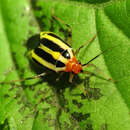en
names in breadcrumbs


This insect, known as the four-lined leaf-bug, is found all over the United States east of the Rocky Mountains, and is a common garden pest, sucking the sap of gooseberry bushes, currants, dahlias and many other plants. The insect passes the winter in the egg stage. The eggs are inserted in slits cut lengthwise into the stems of plants extending through the bark and wood nearly half way to the pith. The slits may be an eighth of inch in length, and into each of them is pushed from two to fourteen eggs. These are crowded side by side, are about 1.6 mm long, smooth, cylindrical, slightly curved, light-yellow in color, and with the outer third capped with a white striate portion. From these eggs the young hatch in the spring— the latter part of May in central New York — and feed upon the tender new growth of leaves for from two to three weeks, undergoing five molts. The adult bugs appear early in June, and often spread to the different surrounding plants. Egg-laying begins in the latter part of June ; the adults disappear in July, and, as above stated, the insect hibernates in the egg stage. There is only one generation each year in New York, but in the southern states there are more. The young insect when first hatched from the egg is of a shining vermilion color, marked with large blackish spots on the thorax. The antennae and legs are of a greenish-black color. The red color is retained until the last stage before the adult is reached, then the large black spots on the thorax seem to mark the beginning of wing pads, which have gradually become more and more apparent after each molt. In the adult insect a radical change in color is found. The general color is bright orange-yellow; the legs and the wing covers are of dark apple-green, but the wing covers and the thorax are marked with four black stripes.
This life history was first worked out by Professor Slingerland, of Cornell University.
Poecilocapsus lineatus, commonly known as the Fourlined Plant Bug,[2] is a species of true bug (Hemiptera) in the family Miridae. This species is native to the United States and Canada.
The adults are about 7–7.5 millimetres (0.28–0.30 in) in length and 3.5 millimetres (0.14 in) in width. Adults have four distinct black lines against a background color ranging from green to yellow, with an orange head and prominent, dark red eyes. Nymphs grow rapidly through five instars, with wing pads growing at each molt. Nymphs are a bright red color with black markings, except for the last instar which is bright orange.[3][4][5]
This species has a wide host range, but shows strong preference for plants in the mint and composite families (Lamiaceae and Asteraceae). Various herbaceous perennials and shrubs in these families are favored for reproduction and account for the majority of damage observed in the landscape and garden, although and vegetables are also sometimes damaged.[6] Both nymphs and adults feed on leaves creating the water-soaked patches of leaf tissues that may later dry up or fall out to produce tiny holes.
This species has only one generation per year. They overwinter in the egg stage, hatching in mid to late spring. Both sexes mate within six weeks after hatching. The timing of egg hatch and development varies. In southern Pennsylvania the eggs hatched from mid to late April, with adults being seen by late May. In the northern part of the same state, the development was 1–3 weeks later. This is also true elsewhere: in the city of Lafayette in Indiana, the development was 2–3 weeks earlier than it was in Ithaca, New York.[7]
The insect is considered to be a minor pest, since it occasionally does damage to herbaceous plants, especially mints, and rarely to woody shrubs or small trees, including forsythia, dogwood, wild hydrangea, and sumac. The species damages plants during the late spring to early summer, with the nymphs causing the majority of plant damage as they feed and develop.[8][9]
Poecilocapsus lineatus, commonly known as the Fourlined Plant Bug, is a species of true bug (Hemiptera) in the family Miridae. This species is native to the United States and Canada.